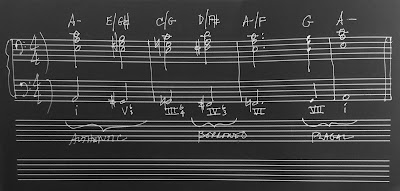Folk Memories (Cont.)
When you compare two separate systems, one from paper (such as musical notation, literally "sheet music"), and one from electronic (the recording studio, "electronic music", even if analog), and compare them, usually you can see the dissimilarities immediately. The problem with copyright lawsuits is that the claim is based on the music notation, when in fact it should be a comparison of the waveform and sample data. In the Stairway lawsuit, comparing the notation reveals they are really not the same, but may appear similar in the world of electronics and data. The same bifurcation happens in visual art, where certain things are possible in each medium, and they aren't ever comparable. Digital paint is not paint, and a chord progression on tape is not the same as a chord progression written in half-notes on a piece of staff paper.
Out of curiosity, and to take out the old rusty harmonic analysis, here's the progression notated. It's an interesting mix of authentic, plagal and "borrowed" changes, so much more refined than Taurus, which I believe inhabits the other world of electronics, not paper.
***
Stravinsky acknowledged that the opening bassoon melody in The Rite of Spring was derived from an anthology of Lithuanian folk songs, but maintained that this was his only borrowing from such sources. If other elements sounded like aboriginal folk music, he said, it was due to "some unconscious 'folk' memory". http://en.wikipedia.org/wiki/Rite_of_Spring
See Folk Memories
Out of curiosity, and to take out the old rusty harmonic analysis, here's the progression notated. It's an interesting mix of authentic, plagal and "borrowed" changes, so much more refined than Taurus, which I believe inhabits the other world of electronics, not paper.
***
Stravinsky acknowledged that the opening bassoon melody in The Rite of Spring was derived from an anthology of Lithuanian folk songs, but maintained that this was his only borrowing from such sources. If other elements sounded like aboriginal folk music, he said, it was due to "some unconscious 'folk' memory". http://en.wikipedia.org/wiki/Rite_of_Spring
See Folk Memories

